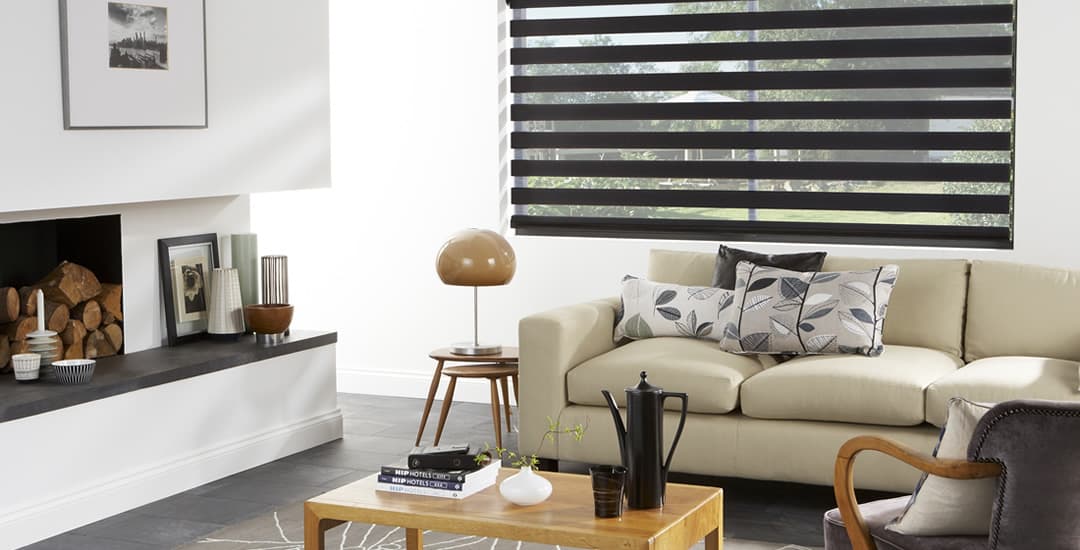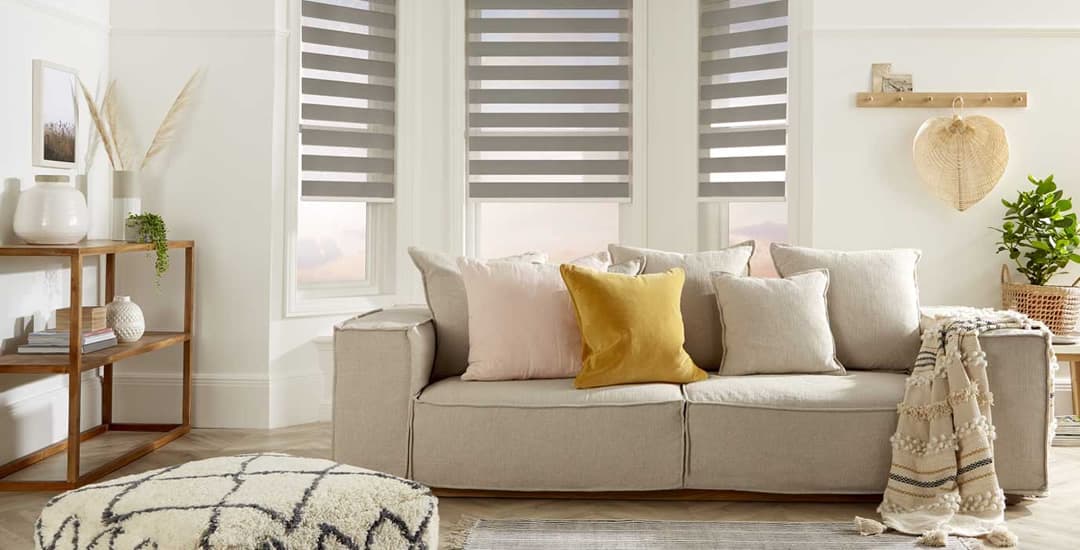
Why choose day night blinds? Because day and night blinds or vision blinds allow you all of the light filtering and privacy options we usually associate with slatted blinds like Venetians, but with the same simplicity, functionality, and smaller profile of roller blinds.
Day and night blinds are made up of a one-piece fabric loop that is comprised of alternating solid and sheer stripes; hence their colloquial name of “zebra blinds.” These stripes are more than just a style choice though, and the alternating solid or non-see-through stripes and transparent or diaphanous stripes give you a huge range of options to control how much light you get, how clear your view of outside is, and how much people from outside can see in too.
That, in a nutshell, is a simple answer to “why choose day and night blinds, and a short-form explanation for what is special about them; the fact they’re commonly known as “zebra blinds” and that this is kind of delightful too, is just an added bonus.
Aren’t day and night blinds just stripey roller blinds?
NOOOO. In terms of how day and night blinds work, what they look like (unique contrasting fabric stripes notwithstanding), and their simplicity, day and night blinds do indeed come across a lot like a gussied-up roller blind.
But zebra blinds are roller blinds in the same way that zebras are horses; They’re not.
They’re close, but one has a bit more going on with it, and also, is less common in the UK. This holds true for both zebras (the sentient, neighing type) and zebra blinds. Day and night blinds in the UK are not always as easy to come by, as they’ve only just really started to catch on here in a meaningful way.
The key difference between how day and night blinds work and what makes them functionally different from roller blinds, is that day and night blinds are made of a loop of fabric that rolls continuously up and down both sides of its bottom tube.
Roller blinds are a sheet, not loop, of fabric that does the up-downs in one direction only; it’s rolled up, unrolled, or somewhere in between, but it’s not chasing its own tail.
Aside from that, while there are indeed striped roller blinds, in rollers this is a design element, or print. In day and night blinds, the stripes are made of two totally different fabrics in both appearance and texture: one solid and one transparent, seamlessly joined into horizontal stripes.
You can also get roller blinds in either a sheer fabric (so it acts kind of like a net curtain but is no good for naked housework with nosy neighbours) or a solid fabric – this latter being far more common, of course – but not in the same blind.
What are the benefits of day and night blinds?
So, why choose day and night blinds over roller blinds? Basically, because they do more. The alignment of the stripes is controlled by your operation of the blind’s side chain, and you can choose to line up the stripes as either a solid, opaque colour block, aligned alternating colour and sheer, or somewhere in between.
This translates as “view both out and in, and light, fully blocked,” versus “plenty of light coming in and view going out, but a little more privacy,” to “somewhere in the middle.”
“Somewhere in the middle” is a popular choice to say, cut screen glare or a particularly persistent sunbeam that’s aiming full on at your laptop screen while you’re trying to work, without leaving yourself sitting in semi-darkness.
Day night blinds can also allow you to direct (or block) sunlight at specific angles to some parts of the room but not others! This has all sorts of applications (some of which I am fully confident I’m nowhere near imaginative enough to have thought of) including keeping plants alive while also keeping yourself from losing your Gran Turismo race because you can’t see your car for the sun.
Oh yes, another thing. The double-layered fabric of day night blinds makes them thermally efficient, which means that fully closed, they help to keep heat in during winter and heat out during summer.
Can you install day and night blinds yourself?
Can you fit day and night blinds yourself? Yes, definitely. Day and night blinds don’t need a specialist fitter or professional blinds dude to get them up to speed. They’re easy to install (much like roller blinds), low maintenance, and easy to keep clean.
While they’re kind of fancy in the functionality department, their component elements of header cassette, fabric body, roller tube, and control cord are very entry-level in the DIY blinds-hanging stakes.
Are day and night blinds child safe?
OMG yes we’re not monsters! (That’s the kids’ job.) Yes, day night blinds are child safe, and were that not the case, it would actually be a bit mean to call a blind something as child-bait as zebra blinds but then add the caveat that they can’t actually be used around children.
All of our day night blinds are child safe, and come with clear instructions on how to securely fix the control cord to make it safe and out of the way for children.
Are day and night blinds stylish?

They’re striped, like a zebra. What’s not to like? We think yes; day and night blinds are stylish. It is certainly fair to say that they’re more or less exclusively a contemporary blind style and so might look a little incongruous in a period home or very classically styled room.
The sheer or netted parts of day and night blinds actually come in a number of different fabric options themselves, which can alter the effect they create and how visible they are from inside of the room looking out too.
When it comes to the solid stripes, these can be made in a huge range of colours. Day and night roller blinds are popular in both contrasting and neutral shades; overall, we probably get asked for grey day and night blinds in various different shades more than any other colour family.
You can also get white day and night blinds, which have a rather subtler visual transition between their solid and translucent stripe, and which I personally think works really well in rooms with a generally light, airy style to them, and possibly white painted furniture or light-coloured woods and natural materials.
Are there any limitations to day and night blinds?
The fact day and night blinds are fairly uncommon in the UK so far means that it can be hard to find a meaningful number of day and night roller blinds reviews and so, get the skinny on any bad points about them, or their potential limitations. So, is there anything that day and night blinds can’t do?
Yes/maybe. Day and night blinds or zebra blinds are made of a fairly high-tech, good quality polyester material (to ensure they stand the test of time and to enable them to be formed seamlessly into stripes), which is treated with a light stiffening agent to make them hang correctly.
This means that day night blinds won’t survive being soaked with water or being regularly exposed to splashes, or living in a very damp or humid environment. This means that for a window right over a sink, day night blinds might not always be a good pick.
They would also be poorly suited to either a kitchen or bathroom that is very small, has poor ventilation, and condensates a lot, or that tends to see a lot of water straying outside of its designated sector (so, within six feet or so of a bath that kids use).
However, day night blinds for bathrooms or kitchens can be a sound choice if the room is airy, well ventilated, and the water stays where it is supposed to be most of the time.
If you’ve got any more specific questions relating to why or how to use day night blinds or whether or not they might be good for a certain room or challenge, let me know and I will advise.




